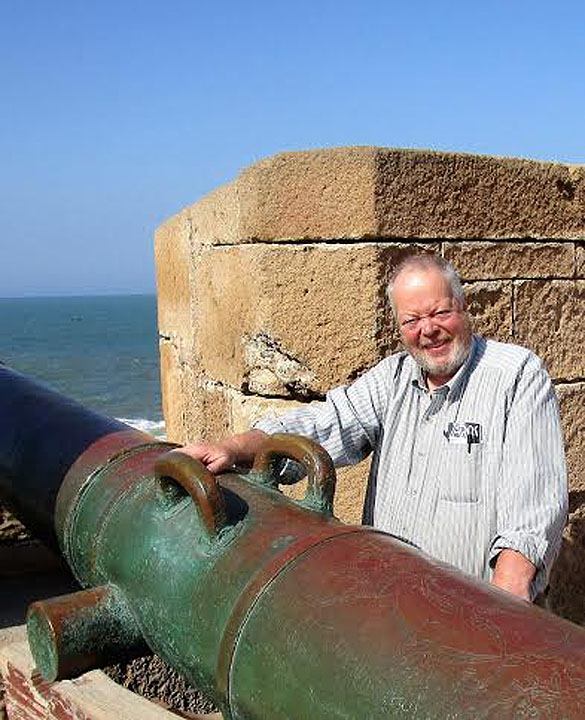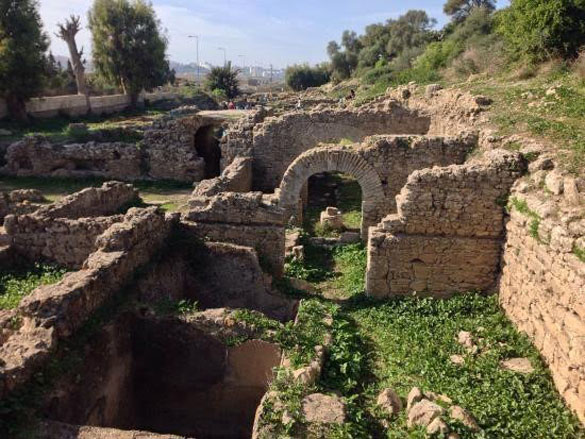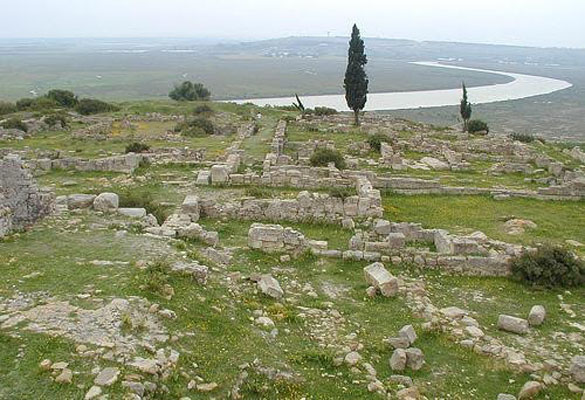 David Griggs next to a cannon on the ramparts at Essaouira, where Orson Welles filmed his 1952 classic version of ‘Othello’. Courtesy photo
David Griggs next to a cannon on the ramparts at Essaouira, where Orson Welles filmed his 1952 classic version of ‘Othello’. Courtesy photoBy DAVID H. GRIGGS
Foreign Correspondent
Los Alamos Daily Post
Los Alamos Daily Post
I apologize for the double pun in the title, and blame it all on the influence of a headmaster under whom I worked early in my career.
It was at this school, also, that I taught a course in Greek Mythology to a rambunctious lot of second, third and fourth graders, who loved to act out the stories of gods and goddesses and heroes and monsters.
So it was with great pleasure that I found myself west of the Pillars of Hercules, exploring the Atlantic Coast of Morocco. I had already completed the obligatory camel ride in the sands of the Sahara Desert to the east, and now I thought I should check out the wet side of Morocco.
Caves of Hercules
With some time to kill between transportation links, I splurged for 300 dirhams for a taxi ride around historic Tangier and then south to the Caves of Hercules. As a fan of mythology, I could not pass up the opportunity to visit Les Grottes d’Hercules. Quite a tourist attraction has developed around the site.
You descend a curving stone path into the depths of the cave, and near the bottom you get an interesting view of the ocean through the rock wall. For years, local laborers cut out round grindstones from the limestone walls and ceilings, resulting in curious curved circular carvings.
According to Greek mythology, Hercules spent a night in this cave during his adventures. To get here, he had to cross a large mountain. Instead of climbing, Hercules used his great strength to smash through it. By doing so, he connected the Atlantic Ocean to the Mediterranean Sea and formed the Strait of Gibraltar.
One part of the split mountain is Gibraltar on the Spanish side and Jebel Musa on the Moroccan. These two mountains taken together have since then been known as the Pillars of Hercules.
Hercules was one of the greatest heroes of Greek and Roman mythology. However, he was easily angered, and his sudden outbursts of rage often harmed innocent bystanders. After one particularly egregious tantrum, he went to the Oracle at Delphi, who sent him to perform a series of labors for King Eurystheus in atonement. These famous labors included such tasks cleaning the Augean Stables in a single day, and slaying such opponents as the Nemean Lion, the Boar, the nine-headed Lernaean Hydra and the Stymphalian Birds, and capturing the Ceryneian Hind, the Erymanthian Boar, and the Cretan Bull.
For another of the labors, Eurystheus commanded Hercules to bring him golden apples which belonged to Zeus, king of the gods. These apples were kept in a garden at the edge of the world, and they were guarded not only by a hundred-headed dragon, named Ladon, but also by the Hesperides, nymphs who were daughters of Atlas, the titan who held the sky and the earth upon his shoulders.
Lixus
And where, you ask, was the Garden of the Hesperides? Ah, that brings me to the ancient site of Lixus, another stop on my travels south along the Atlantic coast of Morocco. Many of the ancients believed that Lixus was the site of the Garden of the Hesperides, home of the famed golden apples.
The history at Lixus goes back to the Romans, when it was part of their colony of Mauretania. Before them, it belonged to the Carthaginians, and before them to the Phoenicians. Most of the ruins are located on a hill on the north side of the River Loukos as it winds toward the ocean. In addition to providing a commanding view of the approaches for defensive purposes, the prominence would have provided good access to cooling sea breezes. The ruins are not as extensive or well-preserved as sites such as Volubilis, but they are also very quiet and pleasant to explore. I was the only tourist there during my visit. A visitors’ center is currently under construction, and will be of great benefit to the site, as will maps and trained guides.
At the foot of the hill are extensive ruins of the garum manufacturing operation that existed there during the Roman period. Garum is a fish sauce that was a flavorful condiment as well as an important nutritional supplement. Garum fish sauce was prized by Roman citizens and soldiers throughout the Empire. It was a major trade item, and amphorae of garum fish sauce have been discovered in Roman shipwrecks from Africa to England, Germany, Greece, and Lebanon.
See the interesting article on garum in “No Tech Magazine” at http://www.notechmagazine.com/.
Barbary Pirates
My base of operations for exploring Lixus was the contemporary city of Larache. Located on the south side of the River Lixus, Larache is a quiet seaside city that is popular in the summer with vacationing Moroccans.
But back in the day, Larache was one of the lairs of the Barbary Pirates. Americans are more familiar with the depredations of the corsairs in the Mediterranean, and the US Marine Corps hymn specifically mentions bringing the battle “to the shores of Tripoli”. But the Atlantic coast of Morocco also was a key part of the Barbary Coast.
Numerous attacks and bombardments of the city by various European powers over several centuries attests to this on-going battle. Larache also built pirate ships made of wood from the nearby Forest of Mamora for the Barbary Corsairs of Salé and Rabat.
Coming into the 19th and 20th centuries, parts of Morocco were gobbled up as European colonies. Larache and the northern part of Morocco were generally under the rule of Spain, and France controlled much of the rest. Morocco gained its independence in 1956. Faded old Spanish hotels and the semi-circular Spanish Plaza in downtown Larache attest to this Spanish heritage.
I stayed at the Hotel Hay Essalam near Spanish Plaza. It is located on Avenue Hassan II, a pedestrian walkway. There are several outdoor cafes at which to sit and sip coffee and watch the people walk past. I enjoyed walking through the plaza in the morning to the café Balcón Atlantico for breakfast and a view of the ocean.
Essaouira
Another stop down the coast is Essaouira, also known by its ancient name of Mogador. It is famous for its multiple shades of blue: blue skies, deep blue sea, blue trawlers and sardine boats loaded with their catch of the day, tiny blue boats huddled against each other, blue shutters and doors on bright white walls. The Phoenicians established a production facility here for indigo dye, and the color is known as royal blue and Mogador blue.
Ideally situated with regard to the trade winds of the North Atlantic, the Barbary pirates who operated out of Mogador prospered by feasting on the triangular trade between Europe, Africa and the Americas 17th – 19th century. Also, goods and slaves from the sub-Saharan Africa through the caravan trade passed through Marrakech, and Mogador was the main port for that ancient imperial city.
The Essaouira fishing port is still very much in operation, and it is interesting to walk down to watch the colorful activity. The boats range from small dories up through large commercial trawlers, and depending on the time and tide you can watch them sailing out to sea and returning and unloading the harvest of the ocean. Keep an eye on the seagulls, and they will show you where men are gutting fish. The cats know where that is happening, too. Afterwards, you may want to stop at one of the nearby restaurant stands and have them grill some fresh fish for you.
I stayed in Atlantic Hostel, a friendly location in the walled medina. Our host Yassine was a wonderful chef, and on most of the evenings I was there, he cooked an excellent dinner for everyone for a reasonable fixed price. In addition to the food, I enjoyed the conviviality and the chance to meet fellow travelers from around the world.
In recent years, Essaouira has become very popular as a windsurfing and kitesurfing destination. From the beach you can see on the hills to the south the Essaouira/Tarfayer Wind Farm, which produces 65,000 kW of electricity. This is one of four large wind farms in the country. With almost 94 percent of its energy requirements being imported, Morocco has for some years now been implementing various renewable energy programs such as solar power, wind energy and hydroelectricity.
Editor’s Note: Since retiring from Los Alamos County in September 2013, David Griggs has been traveling the world. He is a foreign correspondent for the Los Alamos Daily Post, submitting stories and photographs of his travels for publication.
 Remains of a garum fish sauce factory at the Roman town of Lixus. Photo by Suzanna Clarke
Remains of a garum fish sauce factory at the Roman town of Lixus. Photo by Suzanna Clarke Ruins of the ancient site of Lixus, overlooking the River Loukos. Photo by Radoslaw Botev
Ruins of the ancient site of Lixus, overlooking the River Loukos. Photo by Radoslaw Botev
